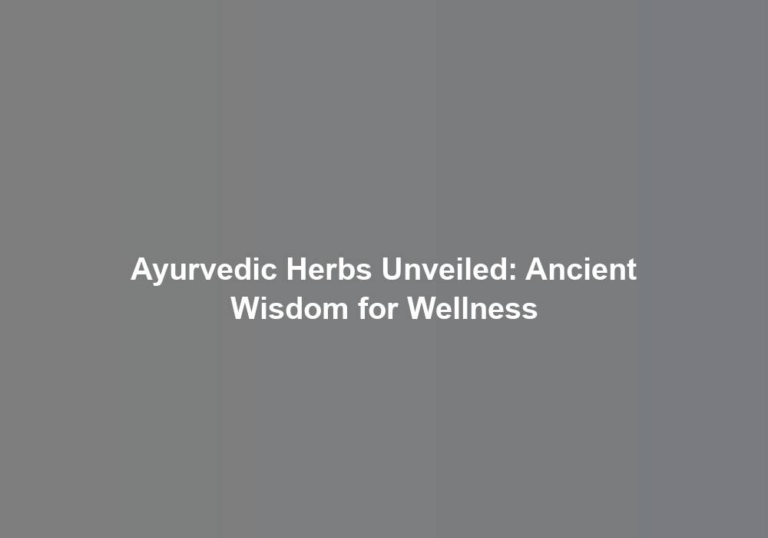Unlocking the Benefits of Popular Herbs: Exploring Turmeric
You may think youG??ve heard all there is to know about herbs, but when it comes to turmeric, prepare to have your assumptions challenged. This golden spice has been making waves in the health and wellness world, and for good reason. Its potential benefits are as diverse as they are impressive, and you wonG??t want to miss out on what this unassuming root has to offer.
Turmeric: A Brief History
Turmeric has been valued for its medicinal properties for thousands of years, with its use dating back to ancient Ayurvedic practices in India. In ancient civilizations, turmeric was not only utilized for its health benefits but also held cultural significance. It was revered as a symbol of prosperity and fertility, often used in rituals and ceremonies. The vibrant yellow spice was also used as a natural dye for clothing and religious ceremonies, further cementing its importance in various cultures.
The cultural significance of turmeric extended beyond India, as it played a prominent role in other ancient civilizations like China, the Middle East, and even ancient Greece. It was highly regarded for its therapeutic properties and was integrated into traditional medicine systems to treat a myriad of ailments.
The rich history of turmeric demonstrates its enduring presence in human civilization and the deep-rooted connection between turmeric and wellness. Its use in ancient societies reflects the intrinsic human desire for natural remedies and a holistic approach to health. Understanding the historical use of turmeric provides insight into its enduring appeal and the basis for its continued relevance in modern herbal practices.
Active Compounds in Turmeric
Turmeric contains key active compounds, such as curcumin, that are known for their potential health benefits. These compounds have been studied for their anti-inflammatory, antioxidant, and even potential anticancer properties. Understanding these active compounds can shed light on the potential health effects of incorporating turmeric into your diet.
Key Active Compounds
Rich in bioactive compounds, turmeric is known for its powerful health benefits. The key active compound in turmeric is curcumin, which has been extensively studied for its anti-inflammatory, antioxidant, and potential anticancer properties. Curcumin is responsible for turmericG??s vibrant yellow color and is known to support the bodyG??s natural healing processes. Additionally, turmeric contains other active compounds such as turmerones and turmerone alcohol, which contribute to its medicinal properties. While turmeric is generally safe for consumption, potential side effects may include gastrointestinal discomfort in some individuals. Furthermore, turmeric may interact with certain medications, so itG??s important to consult with a healthcare professional, especially if you are taking blood thinners or have gallbladder issues. Understanding the key active compounds in turmeric can help you harness its full potential for promoting overall well-being.
Health Benefits
With its rich array of active compounds, turmeric offers a multitude of health benefits that support the bodyG??s natural healing processes and overall well-being. Turmeric supplements have gained popularity for their effectiveness in promoting a range of health advantages. Curcumin, the main active compound in turmeric, is renowned for its anti-inflammatory and antioxidant properties. Its ability to modulate various molecular targets contributes to its therapeutic effects. Research suggests that curcumin may support joint health, aid in digestive issues, and promote cardiovascular well-being. When considering turmeric supplements, dosage recommendations typically range from 500mg to 2,000mg per day, depending on the formulation and individual needs. ItG??s important to consult with a healthcare professional to determine the appropriate dosage for your specific health goals and considerations.
| Health Benefit | Active Compound | Evidence |
|---|---|---|
| Anti-inflammatory | Curcumin | Supports relief from inflammation and associated conditions |
| Antioxidant | Curcumin | Helps neutralize harmful free radicals in the body |
| Joint Health Support | Curcumin | May aid in promoting joint comfort and flexibility |
| Cardiovascular Health | Curcumin | Research indicates potential benefits for heart health |
Health Benefits of Turmeric
Enhance your well-being by incorporating turmeric into your daily routine, as it offers a range of natural health benefits supported by evidence-based research. Turmeric is renowned for its potent anti-inflammatory properties, which can help alleviate various conditions. Curcumin, the active compound in turmeric, has been extensively studied for its ability to reduce inflammation in the body. By incorporating turmeric supplements or adding the spice to your meals, you can tap into this natural anti-inflammatory benefit, potentially easing symptoms of conditions such as arthritis, inflammatory bowel disease, and other inflammatory disorders.
In addition to its anti-inflammatory properties, turmeric is also known for its antioxidant effects. Antioxidants play a crucial role in neutralizing harmful free radicals in the body, which can contribute to aging and various diseases. The curcumin in turmeric acts as a powerful antioxidant, helping to protect your cells and tissues from oxidative stress.
Furthermore, turmeric has been linked to potential benefits for heart health, brain function, and even mood improvement. The natural compounds in turmeric have shown promise in supporting cardiovascular health, cognitive function, and mental well-being. By incorporating turmeric into your daily regimen, you have the opportunity to harness these holistic health benefits and support your overall well-being naturally.
Culinary Uses of Turmeric
Turmeric is an incredibly versatile spice that not only adds a warm, earthy flavor to dishes but also offers numerous health benefits. Incorporating turmeric into your cooking can provide a delicious way to enhance the nutritional value of your meals. Traditional recipes from various cultures have long utilized turmeric for its culinary and medicinal properties, making it a valuable addition to your kitchen repertoire.
Flavoring Dishes With Turmeric
Consider incorporating turmeric into your cooking to add a vibrant and earthy flavor to your dishes while also reaping its potential health benefits. Enhancing flavor with turmeric not only adds a warm, peppery taste but also brings a beautiful golden hue to your culinary creations. Additionally, its anti-inflammatory properties can contribute to your overall well-being. Try sprinkling turmeric into soups, stews, and curries, or use it to season roasted vegetables for a delightful twist. You can also infuse it into rice or quinoa for a pop of color and flavor. When cooking with turmeric, itG??s essential to pair it with black pepper to enhance its absorption. By incorporating this versatile spice into your cooking, you can elevate the taste of your dishes while embracing the potential health benefits it offers.
Health Benefits of Turmeric
To maximize the health benefits of turmeric in your culinary creations, begin by infusing it into a variety of dishes to harness its potential wellness advantages. Turmeric, known for its anti-inflammatory properties, can be a delightful addition to your daily meals. HereG??s how you can unlock its benefits:
- Golden Turmeric Milk: Prepare a comforting warm drink by mixing turmeric with milk, adding a hint of sweetness with honey or maple syrup.
- Turmeric Roasted Vegetables: Toss your favorite vegetables in a mixture of turmeric, olive oil, and a sprinkle of black pepper before roasting for a flavorful and nutritious side dish.
- Turmeric Smoothie: Blend turmeric with fruits, yogurt, and a touch of ginger for a refreshing and health-boosting smoothie.
In addition to culinary uses, consider incorporating turmeric supplements and skincare products to further benefit from its wellness properties.
Turmeric in Traditional Recipes
Discover the rich history and cultural significance of turmeric as it weaves its way into traditional recipes, adding depth and flavor to cuisine across various cultures. Cooking with turmeric is a time-honored tradition, with each culture infusing their unique flavors and techniques into their traditional turmeric recipes. HereG??s a glimpse of how turmeric is used in traditional recipes across different cultures:
| Cuisine | Traditional Dish | Use of Turmeric |
|---|---|---|
| Indian | Golden Milk | Turmeric-infused warm milk with spices and honey |
| Thai | Yellow Curry | A fragrant and spicy coconut milk-based curry |
| Middle Eastern | Turmeric Rice | Aromatic rice dish with turmeric and other spices |
| Moroccan | Chicken Tagine | Slow-cooked savory dish with turmeric and saffron |
| Indonesian | Jamu | A traditional herbal tonic with turmeric and ginger |
These traditional turmeric recipes not only showcase the versatility of this golden spice but also highlight its role in creating beloved dishes that have been passed down through generations.
Turmeric in Traditional Medicine
Turmeric has been revered in traditional medicine for its myriad of health-promoting properties, ranging from its anti-inflammatory and antioxidant effects to its potential in supporting digestive health. For centuries, it has been utilized in traditional medicine to address various health concerns. The medicinal properties of turmeric have been harnessed through time-tested remedies and practices, offering a natural and holistic approach to wellness.
TurmericG??s Traditional Medicinal Uses
-
Anti-inflammatory Benefits: Turmeric has been traditionally used to alleviate inflammation in the body, providing relief for conditions such as arthritis and muscle soreness.
-
Antioxidant Support: Traditional medicine has long utilized turmeric for its antioxidant properties, which help combat oxidative stress and promote overall well-being.
-
Digestive Health: In traditional practices, turmeric has been valued for its potential to support digestive health, aiding in the relief of digestive discomfort and promoting a healthy gut environment.
The traditional uses of turmeric in medicine have been rooted in a deep understanding of the natural world and its healing properties. As you explore the role of turmeric in traditional medicine, you can appreciate the wisdom of ancient healing practices and the profound connection between nature and well-being. Embracing turmeric as part of your holistic wellness routine can offer a sense of belonging to a tradition that spans centuries, providing evidence-based benefits for your overall health.
Incorporating Turmeric Into Your Routine
Incorporating turmeric into your daily routine can enhance your overall wellness by harnessing its natural healing properties and evidence-based benefits. One way to include turmeric in your routine is through skincare. You can create a homemade turmeric face mask by mixing turmeric with yogurt and honey. This can help reduce inflammation, fight acne, and brighten your skin, leaving you with a healthy, natural glow. Remember to do a patch test first, as turmeric can stain the skin.
Another way to integrate turmeric into your daily routine is by adding it to your morning smoothie. A turmeric smoothie can provide a refreshing and nutritious start to your day. Combine turmeric with fruits like mango, banana, and pineapple, add a splash of coconut milk, and a pinch of black pepper to enhance turmericG??s absorption. This vibrant smoothie not only tastes delicious but also offers the anti-inflammatory and antioxidant benefits of turmeric.
Conclusion
So, next time youG??re in the kitchen, donG??t forget to sprinkle some turmeric into your dishes for a flavorful boost and potential health benefits. With its rich history, active compounds, and wide range of health benefits, turmeric is a versatile herb that can easily be incorporated into your daily routine. Whether you use it in cooking or as a supplement, turmeric has proven itself to be a valuable addition to a holistic and natural approach to wellness.







